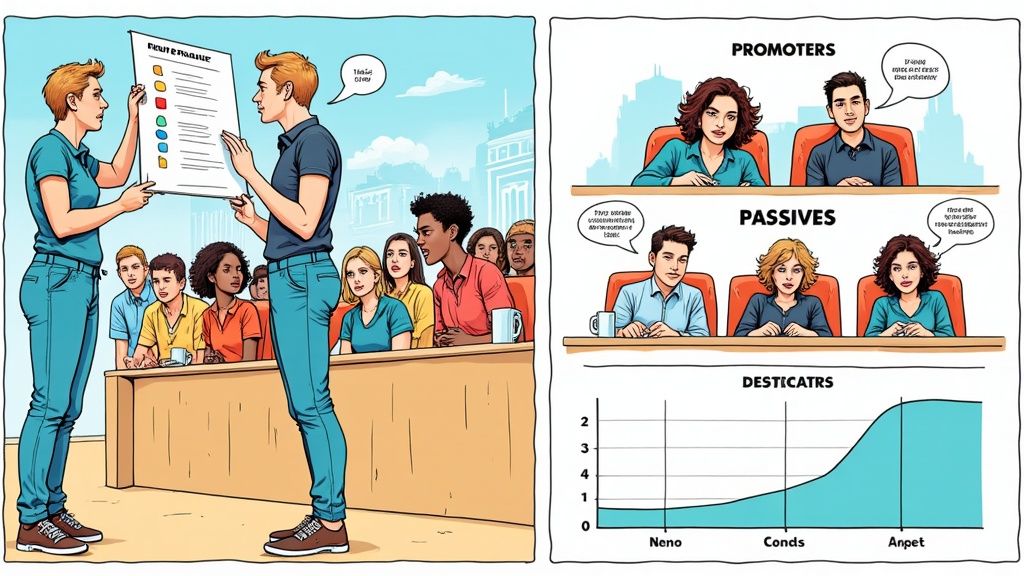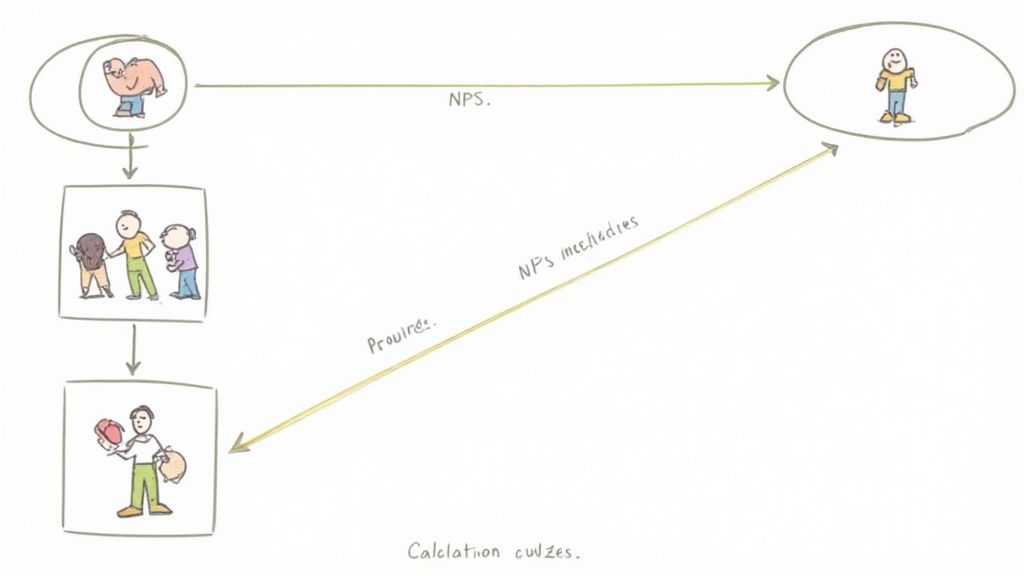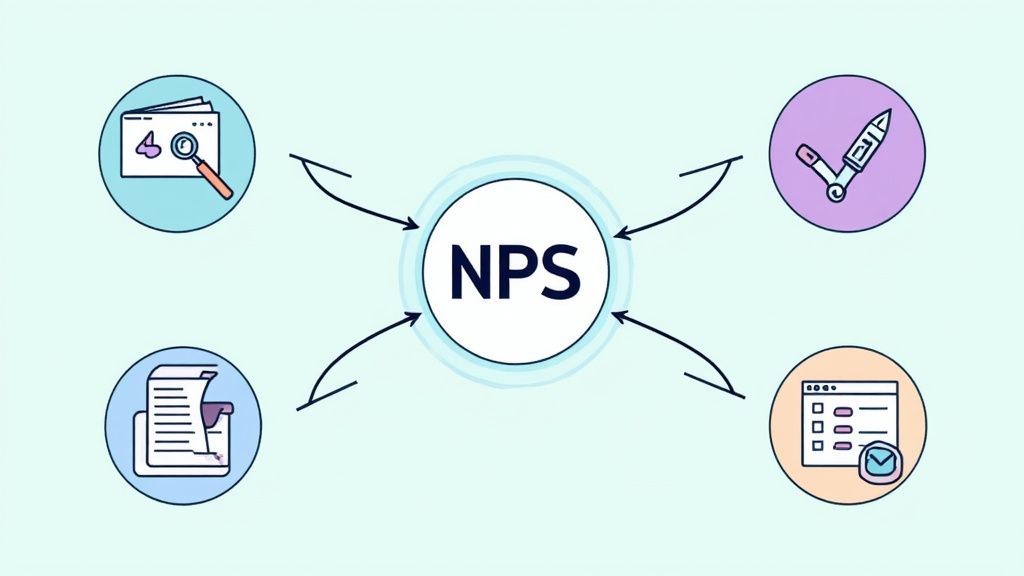How Is NPS Calculated? The Expert Guide to Net Promoter Score Evaluation

Understanding the True Power of NPS Calculation

Net Promoter Score (NPS) has become the go-to metric for measuring customer loyalty. While it may seem basic, this metric offers critical insights into how customers feel about your business. When used effectively, NPS helps companies make smart decisions about improving customer experiences and growing their business.
Breaking Down the NPS Calculation Process
The NPS process starts with one key question: "How likely are you to recommend our business to a friend or colleague?" Customers rate their response on a 0-10 scale, which places them into three groups:
- Promoters (9-10): Your biggest fans who actively recommend you to others
- Passives (7-8): Satisfied customers who could be tempted by competitors
- Detractors (0-6): Unhappy customers who may spread negative feedback
The actual calculation is straightforward. For example, if you survey 100 customers and get 70 Promoters, 10 Passives, and 20 Detractors, your NPS would be: 70% (Promoters) – 20% (Detractors) = 50. This final score ranges from -100 to +100. For more details on NPS calculations, check out this helpful guide from HubSpot.
Beyond just getting a number, NPS helps you understand the makeup of your customer base and what drives their feelings about your company.
From Calculation to Actionable Insights
Getting a high NPS feels great, but the real benefit comes from analyzing how customers spread across the three categories. For example, having many Passives shows you have room to create more enthusiastic supporters. Looking at what makes customers rate you as Detractors helps identify and fix major issues.
Tools like SupportMan make this analysis much easier. By connecting Intercom ratings to Slack, support teams can spot and address unhappy customers right away. Regular reporting also helps track trends and spot areas that need work. This turns NPS from a static measurement into a tool that drives real improvements in how you serve customers.
Mastering the NPS Calculation Formula

The Net Promoter Score (NPS) is a straightforward but powerful metric for gauging customer loyalty. Understanding how to calculate and apply it helps companies make smarter decisions about improving their customer experience.
The Core NPS Calculation
At the heart of NPS is one key question: "How likely are you to recommend [company name] to a friend or colleague?" Customers respond using a 0-10 scale, which sorts them into three groups:
- Promoters (9-10): Your most enthusiastic customers
- Passives (7-8): Satisfied but unenthusiastic customers
- Detractors (0-6): Unhappy customers who may spread negative word-of-mouth
The NPS formula is simple:
NPS = % Promoters – % Detractors
For instance, if you survey 100 customers and get 60 Promoters, 25 Passives, and 15 Detractors, your NPS would be 45 (60% – 15%). This single number gives you a clear picture of customer sentiment. While Passives provide useful feedback, they don't factor into the final score calculation.
You can easily track NPS using common tools like Excel or Google Sheets. For teams wanting more capabilities, SupportMan offers NPS tracking that connects with platforms like Intercom and Slack. Learn more about calculating NPS here.
Practical Application and Data Segmentation
Smart companies take NPS analysis further by breaking down results in meaningful ways. By examining scores across customer groups, product lines, or touchpoints, you can spot exactly where improvements are needed. For example, looking at NPS by customer age group or location helps identify which segments need extra attention.
Ensuring Data Accuracy and Consistency
Getting reliable NPS results depends on good data practices. This means using consistent survey methods, getting enough responses for statistical validity, and watching for any bias in how you collect feedback. Using specialized software can help maintain data quality by automating collection and reducing human error.
When you combine solid NPS calculations with careful data analysis, you can turn customer feedback into real improvements. The key is focusing not just on the numbers, but understanding what drives those scores and taking action to address customer concerns.
Decoding Customer Categories for Strategic Growth
At its core, NPS is about understanding your customers. Beyond the basic calculation lies the key insight: how different customer groups interact with your business. Let's explore the three main categories – Promoters, Passives, and Detractors – and what each means for your growth.
The Power of Promoters
Your Promoters give you 9-10 on the NPS scale, making them your biggest fans. These customers eagerly tell others about their great experiences with your product or service. This organic word-of-mouth drives significant value – think of a software company where satisfied users regularly share positive reviews online and recommend the product to colleagues. The result? A steady stream of new customers who come in with built-in trust.
The Potential of Passives
Scoring you a 7-8, Passives make up a notable portion of most customer bases. While generally content, they aren't actively spreading the word about your business. This creates both risk and opportunity. Without strong loyalty, they might switch to competitors. However, with focused attention on their needs, you can turn them into enthusiastic Promoters. For example, a subscription service could offer personalized product recommendations to boost engagement and satisfaction among these customers.
The Challenge of Detractors
Detractors (scoring 0-6) need the most attention. Their negative experiences can quickly spread and damage your reputation. But here's the silver lining – their feedback often highlights real issues you can fix. By engaging with unhappy customers and solving their problems, you may even convert them to supporters. A restaurant that actively addresses negative reviews shows other customers they care about making things right.
Research shows clear differences in how these groups impact your business. Promoters drive more than 80% of referrals and tend to increase their spending over time. Passives maintain the status quo but rarely advocate for you. Detractors account for over 80% of negative word-of-mouth and have high churn rates. Success means creating more Promoters while reducing Detractors. Learn more about measuring NPS here.
Managing Customer Categories with SupportMan
Effective customer category management directly impacts growth. Tools like SupportMan help you track and respond to feedback across all segments. By connecting Intercom ratings to Slack, your team can quickly address issues, work to satisfy Detractors, and find ways to delight Passives. This real-time insight lets you make targeted improvements that build customer loyalty. When used well, understanding these customer groups transforms NPS from a simple metric into a practical tool for sustainable business growth.
Navigating Common NPS Calculation Pitfalls

While calculating Net Promoter Score (NPS) seems simple on the surface – just subtract Detractors from Promoters – small mistakes can seriously skew your results. Let's explore how to avoid common pitfalls and get accurate, useful insights from your NPS program.
Understanding Response Handling
The way you handle survey responses can make or break your NPS calculations. For example, ignoring neutral responses or unanswered questions can paint an overly positive picture. Some experts suggest counting non-responses as Detractors to get a more realistic view of customer sentiment.
Sample representation is also key. If you only survey your biggest clients, your NPS won't reflect how most customers feel about your business. The solution? Make sure to collect feedback from a diverse cross-section of your customer base.
Avoiding Calculation Errors
Even with a straightforward formula, calculation mistakes happen often. One frequent error is averaging scores across multiple touchpoints instead of treating each interaction separately. This makes it harder to spot trends and areas needing improvement. The better approach is analyzing each customer interaction individually to track sentiment changes over time.
Another mistake is limiting feedback to one response per customer. Since customers interact with businesses in many ways, their experience can vary significantly. Tools like SupportMan help collect feedback through channels like Intercom and Slack, giving you a fuller picture of the customer journey.
Focusing on Actionable Insights
Don't get caught up in minor score changes – look at the bigger picture. While tracking trends matters, obsessing over small fluctuations wastes time and energy. Instead, focus on understanding why scores change by analyzing customer comments. The real value comes from the qualitative feedback that explains the numbers.
By digging into customer explanations, you can identify and fix the root causes of dissatisfaction. This deeper understanding helps you build an effective, customer-focused strategy based on solid data rather than assumptions. Remember that NPS is most valuable when paired with a well-designed survey and commitment to understanding customer sentiment.
Transforming NPS Data into Strategic Insights

Getting your Net Promoter Score is just the start. The real value comes from analyzing the data carefully and using those insights to make smart business decisions. Let's explore how to get the most from your NPS data.
Benchmarking and Trend Analysis
Comparing your NPS against competitors gives you essential context about where you stand in the market. When you benchmark, you can spot both your strengths and areas that need work. If your score falls well below industry standards, it's time to dig into why. Watching how your score changes over time is just as important – steady improvements show you're on the right track, while drops warn you about potential issues.
Connecting NPS to Business Metrics
NPS isn't just about feelings – it directly impacts your bottom line. By linking your NPS to key metrics like customer lifetime value and retention rates, you can see its real business impact. For example, when your NPS goes up by 10 points and retention improves by 2%, you can clearly show how better customer experience drives growth. These connections help prove the value of focusing on customer satisfaction.
Building a Business Case for CX Investment
Your NPS data makes a strong case for investing in customer experience (CX). When you can show clear links between better NPS scores and business results, it's easier to get support for CX projects. Focus on how specific improvements in areas like customer service or product features can boost both NPS and profits. This data-driven approach helps convince stakeholders to back initiatives that will have the biggest impact.
Prioritizing Improvements with NPS Data
Not all customer experience fixes deliver equal results. Your NPS feedback helps you focus on changes that matter most to customers. Look at what Promoters love and what frustrates Detractors to spot the best opportunities. When Detractors keep mentioning slow support response times, that's a clear sign where to focus. SupportMan can help by sending feedback straight to Slack, so your team can quickly spot and fix common issues. This targeted approach helps you invest in changes that will improve both customer experience and your NPS score. By consistently using NPS insights to guide your strategy, you'll build stronger customer relationships and drive real growth.
Building a Sustainable NPS Program
Creating a successful Net Promoter Score (NPS) program goes well beyond just tracking numbers. It requires thoughtful planning, the right tools, and continuous refinement to deliver real value to your organization.
Selecting the Right Tools and Frequency
The foundation of any NPS program starts with reliable data collection tools. SupportMan and similar platforms integrate seamlessly with tools like Intercom and Slack to automate feedback gathering. This approach minimizes manual work and helps ensure your data stays accurate and consistent.
Finding the right survey frequency is essential for meaningful results. Survey too often and you risk survey fatigue. Survey too rarely and you might miss important shifts in customer sentiment. Many companies find success with quarterly relationship NPS surveys combined with event-triggered surveys after key interactions like purchases or support cases.
Building Cross-Functional Support
NPS insights can benefit teams across your organization – not just customer service. Product teams can use detractor feedback to improve features, while marketing teams can better target their campaigns based on customer pain points. Share NPS data widely and help each department understand how they can use these insights to improve their work.
Automating Data Collection and Integration
Setting up automated data collection saves time and improves accuracy. Good tools handle the NPS response gathering and calculations automatically, freeing up your team to focus on analyzing results and taking action.
When you connect NPS data with other business metrics, you gain deeper insights into what drives customer loyalty. For example, you might discover connections between high NPS scores and increased customer lifetime value.
Training Teams and Securing Executive Buy-In
Every team member needs to understand the basics – how NPS works, what the scores mean, and how to use insights to improve their work. Regular training keeps everyone aligned and helps them get maximum value from the program.
Getting leadership support is key for resources and company-wide adoption. Build your case by showing clear links between NPS and business outcomes like revenue growth and customer retention. This helps make customer experience improvement a strategic priority.
Evolving Your Program
As your business grows and changes, your NPS program should adapt too. Regularly review your survey questions, collection methods, and reporting to ensure they still serve your needs. Stay flexible and adjust your approach as you learn more about what influences customer loyalty in your market.
Ready to turn customer feedback into practical improvements? Start your free trial of SupportMan today and see how easy it is to build an NPS program that helps grow your business.
What to do next
Whenever you're ready, here's three ways we can help you scale your support org:
- Claim your free Support Manager Handbook. It's a free 30+ page guide filled with strategies, tactics, and best practices for scaling your support org. Download it here.
- Subscribe to our Support Ops newsletter to get the latest updates here.
- Set up Internal Documentation with Tettra to start automatically answering the questions you get in Slack. Here's how.

